Dave DeWitt’s Digital Bookstore
Here are my favorite classic books available for the first time in digital format. We chose PDFs for download because they are universal and readable on all devices equipped with the proper software. Portions of these PDFs can be printed out, like recipes. These digital books are only available here and nowhere else. Enjoy! —Dave
Nonfiction
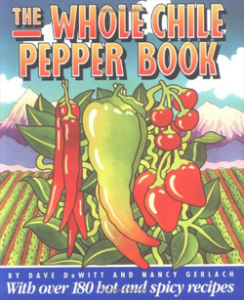 The Whole Chile Pepper Book. By Dave DeWitt and Nancy Gerlach. Boston: Little, Brown & Co., 1990.
The Whole Chile Pepper Book. By Dave DeWitt and Nancy Gerlach. Boston: Little, Brown & Co., 1990.This is Dave and Nancy’s all-time best-selling book, with 120,000 copies in print. Discusses the identification, cultivation, preservation, and culinary history of chile peppers and features 180 recipes for stews, soups, casseroles, and entrees.
1990 review: “DeWitt and Gerlach are the editors of The Whole Chile Pepper magazine and authors of two previous books on spicy food. Their new collection is well researched and full of information, and the recipes from all over the world range from updated pre-Columbian dishes to New Southwestern-style creations. The number of chile addicts seems to be increasing daily; for most collections.” – Library Journal
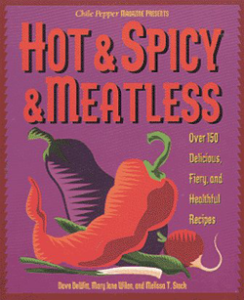 Hot & Spicy & Meatless, by Dave DeWitt, Mary Jane Wilan, and Melissa T. Stock. Rocklin, CA: Prima Publishing, 1993.
Hot & Spicy & Meatless, by Dave DeWitt, Mary Jane Wilan, and Melissa T. Stock. Rocklin, CA: Prima Publishing, 1993.Contains meatless recipes culled from all over the world–for delicious hot and spicy meals that are all natural, low in calories, and low in fat. More than 40,000 copies in print.
1993 review: “More than 150 spicy and healthy recipes from Southeast Asia, the West Indies, the American Southwest, Mexico, Madagascar, and other hot spots. Sonoran Enchiladas, Sri Lankan Eggplant Surprise, Hot Lemon Peel Soup with Roasted Garlic and Peppers, Bangkok Nachos, and more. Includes appendices on the healthful properties of chile peppers and growing your own chile garden.” –Amazon.com
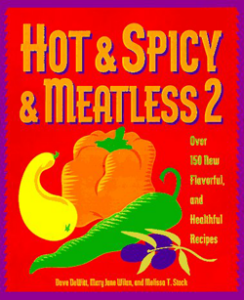 Hot & Spicy & Meatless 2: Over 150 New Flavorful and Healthful Recipes, by Dave DeWitt, Mary Jane Wilan, and Melissa T. Stock. Rocklin, CA: Prima Publishing, 1996.
Hot & Spicy & Meatless 2: Over 150 New Flavorful and Healthful Recipes, by Dave DeWitt, Mary Jane Wilan, and Melissa T. Stock. Rocklin, CA: Prima Publishing, 1996.You don’t need meat for hot, spicy flavor, but you might need a fire hose to wash down this latest all-new collection of red-hot vegetarian fare. Once again, Dave DeWitt, Mary Jane Wilan, and Melissa T. Stock have collected recipes from the American Southwest and the world over. They’ve conveniently rated each dish from mild to extremely hot, and suggested substitutions for those who want to turn the temperature down—or up! The authors garnish it all with a quirky, informed, running commentary on nutrition, eating habits, the history of food, and more. So be brave—sample this scorching assortment:
- Fiery Ginger Eggplant Dip
- Red Hot Lover’s Vegetarian Lo Mein
- Spicy Creole Rice
- Sun-Dried Tomato Bisque
- Spicy Moroccan Clay Pot Vegetables
- Jalapeño Margaritas
- Bombay Curried Eggs Stuffed in Crepes
- Mango Habanero Sorbet
- and many more fiery delights!
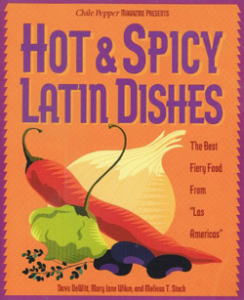 Hot & Spicy Latin Dishes: The Best Fiery Food from Las Americas, by Dave DeWitt, Mary Jane Wilan, and Melissa T. Stock. Rocklin, CA: Prima Publishing, 1994.
Hot & Spicy Latin Dishes: The Best Fiery Food from Las Americas, by Dave DeWitt, Mary Jane Wilan, and Melissa T. Stock. Rocklin, CA: Prima Publishing, 1994.Featuring fiery recipes like Peruvian Walnut Chicken, Guyana Pepperpot Soup, Gallo Pinto with Hot Sauce from Costa Rica, and Nicaraguan Jalapeño Pork Salad, this collection is a Latin American tour de force. Other hot recipes include Carne Quisado from Guatemala, Chorizo Sausage from Argentina, and Duckling with Spicy Wine Sauce from Colombia.
1994 review: “The Chile Pepper magazine gang is back again with more hot stuff. DeWitt and his colleagues are the authors of many other cookbooks on spicy cuisines, and this collection includes recipes from all over Central and South America, from salsas and appetizers to desserts and drinks. The emphasis on heat will attract the growing audience of chile lovers; however, because there are few recent general cookbooks on this area, other than Felipe Rojas-Lombardi’s excellent The Art of South American Cooking (LJ 10/15/91), Hot and Spicy should have broader appeal as well. For most collections.” – Library Journal
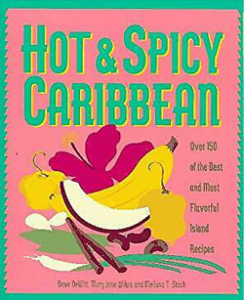 Hot & Spicy Caribbean: Over 150 of the Best and Most Flavorful Island Recipes, by Dave DeWitt, Mary Jane Wilan, and Melissa T. Stock. Rocklin, CA: Prima Publishing, 1995.
Hot & Spicy Caribbean: Over 150 of the Best and Most Flavorful Island Recipes, by Dave DeWitt, Mary Jane Wilan, and Melissa T. Stock. Rocklin, CA: Prima Publishing, 1995.Treat yourself to savory meals from the spicy islands! Hot & Spicy Caribbean is a comprehensive survey of more than 150 delicious hot and spicy dishes culled from the authors’ 25 years of culinary escapes in the islands. Along with mouthwatering food, you’ll find amusing anecdotes revealing local color and history, a complete glossary of spicy terminology, and a listing of mail-order sources for hard-to-find ingredients. But most of all you’ll learn how to prepare sensational recipes, including:
• Jamaican Pepper Pot Soup
• Flash in the Pan Snapper
• Spicy Caribbean Black Beans
• Creole Congo Pepper Sauce
• Caribbean Crab Gumbo
• Rum-Drenched Duckling
• Bajan Coconut Milk Sorbet
• Antigua Orange Cake
• and many more hot tropical treats!
Each savory recipe is rated for heat, so you can make it mild, medium, hot, or super-hot! You’ll also find a sampling of cool-down accompaniments to round out your culinary tour of the islands.
“DeWitt is professionally wired for high voltage food.”
— Barbara Durbin, Portland Oregonian
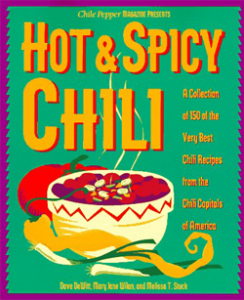 Hot & Spicy Chili: A Collection of 150 of the Very Best Chili Recipes from the Chili Capitals of America, by Dave DeWitt, Mary Jane Wilan, and Melissa T. Stock. Rocklin, CA: Prima Publishing, 1994.
Hot & Spicy Chili: A Collection of 150 of the Very Best Chili Recipes from the Chili Capitals of America, by Dave DeWitt, Mary Jane Wilan, and Melissa T. Stock. Rocklin, CA: Prima Publishing, 1994.A food history of the bowl o’ red plus a collection of award-winning chili recipes from the Hot and Spicy series of Chile Pepper magazine. It includes a variety of favorite chili con carne, meatless, and bean chili recipes, as well as appropriate side dishes. Original. This is probably the best food history of chili con carne ever written.
Historical recipes include:
- Chili H. Allen Smith
- Lady Bird Johnson’s Pedernales River Chili
- Sam Pendergrast’s Original Zen Chili
- Joe Cooper’s Chili
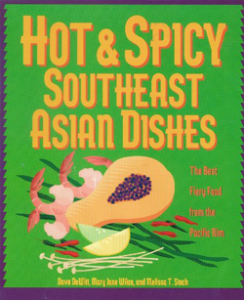
Hot & Spicy Southeast Asian Dishes: The Best Fiery Food from the Pacific Rim, by Dave DeWitt, Mary Jane Wilan, and Melissa T. Stock. Rocklin, CA: Prima Publishing, 1995.
From the Hawker Centres of Singapore to the Floating Markets of Bangkok, the authors present the best fiery Asian recipes that they collected, including:
- Indonesian Peanut—Chile Sauce
- Red Curry Paste
- Fried Crab and Pork Rolls
- Hot Chile and Seafood Soup
- Singapore Noodles
- Spicy Mixed Satays
- Lemongrass Chicken
- Prawns in Chile-Garlic Sauce
- Yellow Festive Rice
- Also included in the book are humorous and informative sidebars and an Asian market glossary.
“No one knows more about fiery foods than Dave DeWitt.” –Steven Raichlen, author of The Barbecue Bible
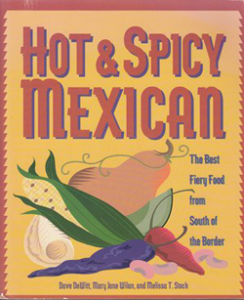 Hot & Spicy Mexican: The Best Fiery Food from South of the Border, by Dave DeWitt, Mary Jane Wilan, and Melissa T. Stock. Rocklin, CA: Prima Publishing, 1996.
Hot & Spicy Mexican: The Best Fiery Food from South of the Border, by Dave DeWitt, Mary Jane Wilan, and Melissa T. Stock. Rocklin, CA: Prima Publishing, 1996.Experience the chile cuisine of Mexico! This is the sixth book of the hot & spicy series, and the first time we have ever featured a single country, but there are more varieties of chiles grown in Mexico than any other country. Mexicans often call chiles the “soul of their cuisine.” The names of some of the favorite Mexican chiles are ancho, pasilla, chiltepin, habanero, jalapeño, and serrano.
From Yucatán to Sonora, the hot & spicy team has collected the best chile recipes from Mexico–180 of them, along with fascinating culinary anecdotes and a glossary of chiles. Recipes range from pre-Columbian chile specialties to recipes from contemporary chefs. Some recipe titles are:
- Sopa de Lima con Habaneros (Lime Soup with Habanero Chiles)
- Pollo en Escabeche Oriental (Shredded Chicken Yucatán-Style)
- Salpicón (Radish and Chile Salsa)
- Chiles Poblanos en Nogada (Stuffed Poblano Chiles in Walnut Sauce)
- Enchiladas Estilo Sonora (Sonoran-Style Enchiladas)
- Mole Negro de Oaxaca (Oaxacan Black Mole with Chicken)
- Chiles Anchos Encaramelados con Picadillo en Salsa de Aguacate (Caramelized Ancho Chiles with Picadillo in Avocado Sauce)
To Chileheads around the country, DeWitt is the high priest of hot stuff.” –Sam Gugino, San Jose Mercury News
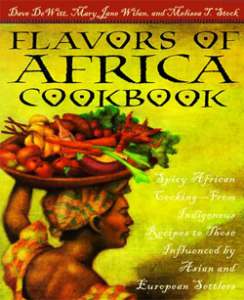 Flavors of Africa Cookbook: Spicy African Cooking – From Indigenous Recipes to Those Influenced by Asian and European Settlers, by Dave DeWitt, Mary Jane Wilan, and Melissa T. Stock. Rocklin, CA: Prima Publishing, 1998.
Flavors of Africa Cookbook: Spicy African Cooking – From Indigenous Recipes to Those Influenced by Asian and European Settlers, by Dave DeWitt, Mary Jane Wilan, and Melissa T. Stock. Rocklin, CA: Prima Publishing, 1998.Journey to this most fascinating of continents and taste its delightfully unique and aromatic flavors. From spice-laden Arabic dishes of the north to the indigenous dishes of Africa’s tropical center to the blended flavors of the “Old Cape Cookery” in the south, this book introduces you to a world of culinary wonders.
Enjoy such tantalizing dishes as:
- Cape Town Curried Capsicum Prawns
- West African Banana and Chile Fritters
- Sweet-Hot Corn Cakes
- African Gumbo
- Ethiopian Chicken Stew
- Lamb Couscous with Onions and Raisins
- Peppered-Peanut Beef Kababs
- Curried Coconut Soup
- Papaya Ginger Beef with Piri Piris
- Sidi’s Tamarind and Coconut Chicken
- Seafood Strudel with Sweet and Hot Pepper Sauce
- Includes glossary, mail-order sources, and more!
1998 review: “In or out of Africa, you can eat as the Africans do with Flavors of Africa, a compendium of delicious cuisines from the far-flung corners of the continent. Whether we’re talking Feisty Fish Cakes from West Africa, Tajine Tafarout from Morocco, or Nigerian Ginger Cake, the emphasis in all these recipes is on spice. The first chapter in the book describes the multitude of spices available throughout Africa: North African Harrissa, South African curries, East African piri-piri sauces, and Berbere from Ethiopia–all based, in some part, on chile peppers. Imagine a plate of Sweet-Hot Corn Cakes, some Curried Coconut Soup, or West African Banana and Chile Fritters–a meal guaranteed to sizzle your taste buds and bring tears of joy (and heat!) to your eyes.” –Amazon.com
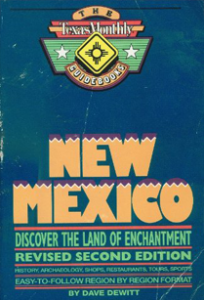 New Mexico: Discover the Land of Enchantment, by Dave DeWitt. Houston: Gulf Publishing Company, 1994.
New Mexico: Discover the Land of Enchantment, by Dave DeWitt. Houston: Gulf Publishing Company, 1994.This book is still the most complete and comprehensive guidebook written about this beautiful, varied state, and includes hundreds of updated entries. It has an easy-to-follow region by region format and covers history, archaeology, shops, restaurants, tours, and sports.
1994 review: “I am no stranger to vacationing in New Mexico and I can see where this guidebook will be a big help on my next trip to or through the Land of Enchantment.” – Larry Lawrence, Abilene Reporter News
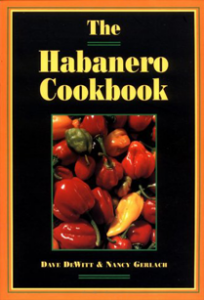 The Habanero Cookbook, by Dave DeWitt and Nancy Gerlach. Berkley, CA: Ten Speed Press, 1995.
The Habanero Cookbook, by Dave DeWitt and Nancy Gerlach. Berkley, CA: Ten Speed Press, 1995.Back in the 1990s, everyone thought that the habanero was the hottest pepper in the world. It wasn’t, but it was the hottest pepper that anyone could obtain or grow, so a “habanero cult” of sorts emerged and its popularity soared. Chile pepper experts Dave and Nancy took on the project of writing a history of that pod and collecting numerous recipes during their research travels. Some of those very hot recipes include:
- Belizean Habanero Hot Sauce
- Peach-Habanero Chutney
- Campeche Shrimp Cocktail
- Jerk Pork
- Deviled Crab Cakes
- Black Bean Picadillo
- Pasta from Hell
- Spiced-up Rice and Peas
The book is four-color throughout and has more than 100 recipes.
Goodreads review: “I became hooked on growing and cooking with many different varietals of Habs after making several recipes from this cookbook. A classic for heat lovers.” – Lulu
eBay review: “At last, here’s the inspired salute to habaneros that chile lovers have been waiting for. Chile experts Dave DeWitt and Nancy Gerlach (the editors of Chile Pepper magazine) visited pepper farms, sauce and salsa makers, and habanero aficionados from the Yucatán peninsula to New Mexico, to gather the secrets of enjoying the world’s hottest pepper. In The Habanero Cookbook, they share more than 100 of the very best recipes they found and much more.”
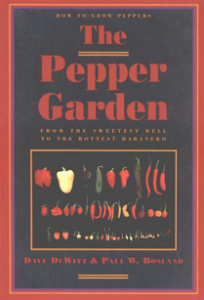 The Pepper Garden, by Dave DeWitt and Paul W. Bosland. Berkley: Ten Speed Press, 1993.
The Pepper Garden, by Dave DeWitt and Paul W. Bosland. Berkley: Ten Speed Press, 1993.You can grow and enjoy chile peppers in your backyard, whether you live in the hot Southwest or a colder northern climate. This guide tells you everything you need to know, including recommendations for which ones to grow and botanical descriptions of the most popular types. The authors are pepper experts and offer all of their tips and techniques for choosing good seed, starting your plants out right, and planting your garden with companion plants that are good to eat with peppers—such as tomatoes, onions, corn, basil, oregano, and garlic. Easy step-by-step instructions, a list of seed sources, and a glossary of terms will help the gardening novice, and there are full details on harvesting the pods; drying and roasting peppers; and making festive ristras (hanging strands of red peppers). Whether you are an avid gardener or a chile pepper lover wanting to grow your favorites, The Pepper Garden will be your guide to successful chile pepper gardening.
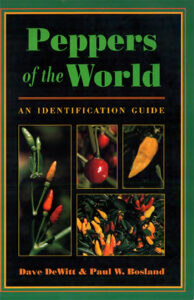 Peppers of the World: An Identification Guide, by Dave DeWitt and Paul W. Bosland. Berkley: Ten Speed Press
Peppers of the World: An Identification Guide, by Dave DeWitt and Paul W. Bosland. Berkley: Ten Speed PressThis comprehensive pictorial guide to Capsicum identification provides a fine color photograph and a detailed description for each of hundreds of peppers from Mexico, Hungary, Thailand, Malaysia, Taiwan, Guatemala, Trinidad, Jamaica, Cayman Islands, and numerous locations in the US. The peripatetic, pepper- breeding authors provide an informative introduction and list seed sources.
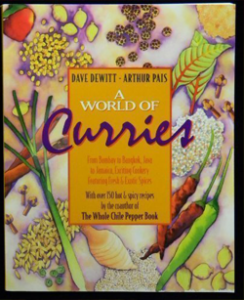 A World of Curries: From Bombay to Bangkok, Java to Jamaica, Exciting Cookery Featuring Fresh and Exotic Spices, by Dave DeWitt and Arthur Pais. Boston: Little, Brown & Co., 1994.
A World of Curries: From Bombay to Bangkok, Java to Jamaica, Exciting Cookery Featuring Fresh and Exotic Spices, by Dave DeWitt and Arthur Pais. Boston: Little, Brown & Co., 1994.A food history of worldwide curries that features 150 recipes from India, Sri Lanka, Thailand, Sumatra, Africa, Punjab, and the West Indies, interwoven with local curry lore and traditions.
Reviews:
From Publishers Weekly
Is a cookbook devoted exclusively to curry really needed? Yes; and this one convinces in many different respects. Taking a historical look at the genre, for example, DeWitt (The Whole Chile Pepper Book) and New York Newsday writer Pais note that St. Thomas made what was to be a brief stop on the Malabar Coast of Kerala, but the local curries (shrimp) detained him. The book will also detain. Its range is adventurous, seeking out diverse specialties of the subcontinent (“India is like Europe multiplied several times”) and also researching what became of curries that wandered and transmuted in Burma, Thailand, Malaysia, Africa, Hawaii, Australia, Jamaica and elsewhere. The authors clarify rumor and myth concerning curry, explain basic foodstuffs and their uses (e.g., ghee), and then launch into the recipes, which include dishes meant to accompany curries (breads, chutneys, salads) as well as the main event. The result is a curried geography, with many standouts, including shrimp with cardamon and almonds from Fiji, sosaties (kebab) and bobotie (casserole) from South Africa, and Burmese pumpkin curry. Not all will inflame, and not all are meant to.
From Library Journal
DeWitt, editor of Chile Pepper magazine, is the author of numerous books on hot and spicy food, including The Whole Chile Pepper Book ( LJ 11/15/91); Pais, who grew up in India, is a writer and contributor to Chile Pepper. Together, they have pooled their knowledge to write an authoritative and mouth-watering guide to curries of all sorts from around the world. They begin, of course, with India and the history of curries there. Then, traveling from Southeast Asia and the Spice Islands to Africa to the Caribbean, they present more curries and curry lore, along with an assortment of accompaniments and other spiced dishes. With a readable, informative text and dozens of recipes for sophisticated dishes as well as everyday fare, this is highly recommended.
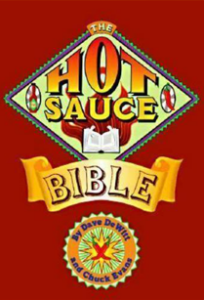 The Hot Sauce Bible, The Crossing Press, April 1, 1996.
The Hot Sauce Bible, The Crossing Press, April 1, 1996.In case you didn’t know it, collecting hot sauces is becoming an increasingly popular hobby. This is the first hot sauce book ever published. It’s a must-have cookbook for every red-hot lover of spicy food. The Hot Sauce Bible is packed with details on more than 1,700 sauces and brims with folklore, anecdotes, hot sauce history, dozens and dozens of recipes, and more. Chuck Evans is the coauthor.
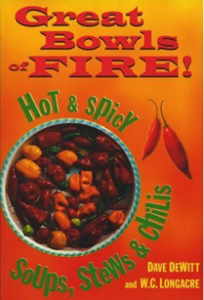 Great Bowls of Fire!: Hot and Spicy Soups, Stews and Chilis, Ten Speed Press, November 1, 1997.
Great Bowls of Fire!: Hot and Spicy Soups, Stews and Chilis, Ten Speed Press, November 1, 1997.Written with W.C. Longacre, Great Bowls of Fire is the ultimate recipe book for cooking spiced-up soups, stews and chilis.
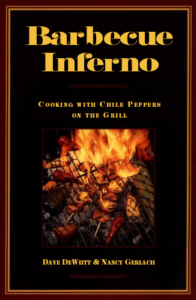 The Barbecue Inferno: Cooking with Chile Peppers on the Grill, by Dave DeWitt and Nancy Gerlach. Berkley: Ten Speed Press, 2001.
The Barbecue Inferno: Cooking with Chile Peppers on the Grill, by Dave DeWitt and Nancy Gerlach. Berkley: Ten Speed Press, 2001.Combining fire with flame, chile experts Dave DeWitt and Nancy Gerlach present a collection of recipes designed to bring your grill alive and set your taste buds ablaze. Barbecue Inferno covers the basics of cooking with chile peppers on the grill and in a smoker, offering up fiery recipe after recipe for meat, seafood, and vegetable dishes. From Margarita-Grilled Shrimp and Avocado Quesadilla to Thai Ginger Pork Steaks; from Armenian Spiced Lamb Brochettes to Southwestern Grilled Chicken Caesar Salad with Chile-Dusted Croutons, the authors draw on cuisines from around the globe in their gastronomic quest for fire.
2001 review: “This is DeWitt and Gerlach’s ninth book, and their passion for their subject hasn’t cooled a bit. They still insist on the merits of spicing up everything in creation with a chile or two or four, and they still obviously have a lot of fun doing it.”— The Winston Salem Journal
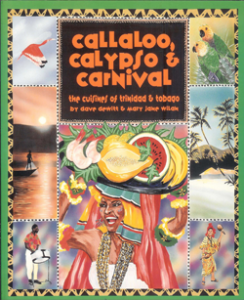 Callaloo, Calypso & Carnival: The Cuisine of Trinidad and Tobago, by Dave DeWitt and Mary Jane Wilan. Freedom, CA: The Crossing Press, 1993.
Callaloo, Calypso & Carnival: The Cuisine of Trinidad and Tobago, by Dave DeWitt and Mary Jane Wilan. Freedom, CA: The Crossing Press, 1993.Callaloo, Calypso & Carnival is the only book on the fascinating, multi-cultural cuisines of the country of Trinidad & Tobago. Mostly a cookbook, it is part travel guide and celebration of the music and spirit of the country. The book explores the food traditions of Trinidad & Tobago, which combine African, East Indian, European, Chinese, and Native American elements. There are more than 100 recipes–most highly spiced–that cover everything from classic Pepperpot to Curried Lobster. In addition to all the food, the book explores the unique musical history of Trinidad & Tobago that culminates in one of the greatest Carnival celebrations anywhere in the world.
There is a glossary of Trinidad & Tobago food terms, a bibliography, and a discography. This book is a must for lovers of all things Caribbean.
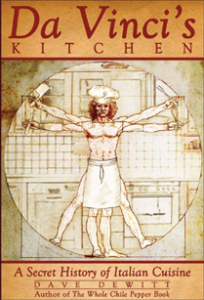 DaVinci’s Kitchen, by Dave DeWitt.
DaVinci’s Kitchen, by Dave DeWitt.Part history, part biography, and part cookbook, this fascinating exploration of an as-yet unexamined facet of Leonardo da Vinci’s life focuses on what and how he ate. Da Vinci lived to be 67—nearly twice the average life span at the time—and his longevity may well have been due to his diet, which is reconstructed here complete with his notes on ingredients, portions, cooking, drinking, and kitchen inventions. The great artist, scientist, and inventor was no slouch in the kitchen, having worked as a kind of theatrical caterer, producing feasts with extravagant menus for royalty. This book unlocks his cooking code and the food history of his day, bringing 30 recipes up to date, including da Vinci’s own salad dressing and an exotic saffron risotto with duck and mushrooms fit for a Medici.
Review
From Publishers Weekly
Starred Review. Though it seems the title of this book is a bid to profit by association with a certain global bestseller-the topic of “Leonardo’s Larder” takes up just one chapter-it’s easy to forgive this well-researched history, a fascinating look into the eating habits of 15th and 16th-century Italy. Delving into formal feasts, foreign crops and the Arabic influence on Italian cooking, DeWitt (The Chile Pepper Encyclopedia) also includes chapters on “The First Superstar Chefs” and what your seat says about you: “honored guests were seated with their backs to the fire … it was an exercise in social standing … governed by strict protocol.” The author liberally quotes Renaissance food authorities like Platina, an early librarian at the Vatican who wrote what is likely the first printed cookbook. He also references modern food scholars like Waverly Root and Odile Redon, and includes historical recipes for Renaissance favorites like Risi e Bisi and Spinach Soup with Hazelnuts. Detailed and passionate, this book is unlikely to appeal to a broad audience, but for foodies who want an in-depth exploration of the roots of Italian cuisine, one can hardly go wrong here.
Fiction
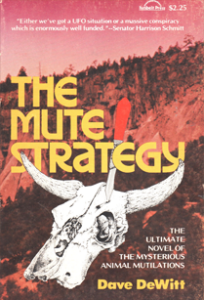 The Mute Strategy: The Ultimate Novel Of the Mysterious Cattle Mutilations, by Dave DeWitt. Albuquerque: Sunbelt Press, 1979.
The Mute Strategy: The Ultimate Novel Of the Mysterious Cattle Mutilations, by Dave DeWitt. Albuquerque: Sunbelt Press, 1979.This book is a fictionalized and exaggerated account of events that transpired in the American Southwest and particularly New Mexico in the mid- to late-1970s.
The tiny New Mexico town of Las Sombras has been stunned by the discovery of more than 100 cattle killed and mutilated in one night—the largest slaughter yet in the wave of brutal mutilations sweeping the western ranches. Bob Gallegos and Sheriff Louie Baca are baffled by the seemingly endless blind alleys they encounter during their investigation. Then they find the body of Mary Castillo cut up just like the cows. It was time for The Mute Strategy.
1980 review: “Based upon the mysterious realities of today, The Mute Strategy is a chillingly accurate novel about the puzzling mutilation phenomenon…totally engrossing and highly entertaining…definitely recommended.” – Judith Ritter, Taos Magazine
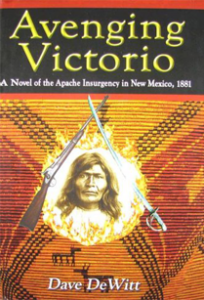 Avenging Victorio: A Novel of the Apache Insurgency in New Mexico in 1861, by Dave DeWitt. Albuquerque: Rio Grande Books, 2007.
Avenging Victorio: A Novel of the Apache Insurgency in New Mexico in 1861, by Dave DeWitt. Albuquerque: Rio Grande Books, 2007.A rag-tag group of Apache warriors, led by an elderly man in his late seventies, took on the U.S. Army’s Ninth Cavalry in revenge for the death of the great Apache war chief Victorio. Using guerilla warfare, they led raids through New Mexico, slaughtering men, women, and children and evading the Cavalry and the Buffalo Soldiers. In the end, they won! Interesting historical characters abound. Billy the Kid was killing people in the southern part of the territory. The New Mexico Territory was governed by Lew Wallace (author of Ben-Hur and territorial governor). Colonel Edward T. Hatch (the chile town of Hatch is named for him) was in charge of the U.S. Army’s Ninth Cavalry. And the great Apache war chief Victorio had been killed by the Mexican Army. After Victorio (a supposed treasure trove is named after him) was killed, the elder war chief Nana led the Apache to victory.
Avenging Victorio Awards
Winner, 2008 New Mexico Book Awards, “Best Adventure Novel”
Finalist, 2008 INDIE Excellence Book Awards
Silver Medalist, 2007 Foreword Magazine Book of the Year
Finalist, 2007 National Best Book Awards
Finalist, 2007 Southwest Books of the Year, Tucson-Pima Library System
Avenging Victorio Reviews
“Dave DeWitt’s 1880s battle novel is so well-crafted, it’s hard to believe he wasn’t actually there. DeWitt has crafted an entertaining, enlightening novel that will hopefully not be his last. It’s well-known that an attention to detail differentiates a good chef from a great one; DeWitt’s skills have clearly carried over into the realm of novel writing.” — Tucson Weekly
“Provides a fascinating glimpse into a frequently forgotten event in New Mexico. Great reading, good antidote against the winter cold.” — Albuquerque Journal
”(DeWitt) heats up the action and puts your interest level in high gear… in this unique novel that is one of the best I’ve read this year.” — MyShelf.com.
“Superbly portrays the cultural differences and motivations … grows like a hunger!” — POSH Magazine
”
Balanced … quite vivid … likely to whet the reader’s appetite to learn more!” — Amazon.com
Dramatic, moving story … historical fiction at its best! Powerful! This is a book for every American citizen to read and pass along to their offspring. Brilliantly written, this is a story that will haunt the reader long after the cover is closed.” — Amazon. com
This swiftly moving tale of death and revenge has long needed to be told. — True West Magazine, October 2007
“Effectively fictionalizes… DeWitt’s storytelling weaves together the perspectives of the opposing sides, providing insight into the events of the period, and the personalities, motivations and cultural differences of the key players in the conflict…. dynamic narrative format builds suspense as the reader eagerly awaits the discovery of which strategies will ultimately accomplish each side’s goal—defeating the enemy… creates a kinship between a contemporary reader and the usually intangible characters of New Mexico’s past.” — New Mexico Magazine, September 2007
“Historical fiction at its best. I especially appreciated DeWitt’s detail in describing the traditions, customs, and celebrations of the Apache Indians. …. This is a book for every American citizen to read and pass along to their offspring. The story is a reminder of the high price paid by the frontiersman and settlers of the West. It is also a reminder of the high price paid by the American Indian in their attempt to maintain their land, culture and way of life. Brilliantly written, this is a story that will haunt the reader long after the cover is closed on the last chapter.” — Midwest Book Review, November 2007 and Amazon.com, September 19, 2007
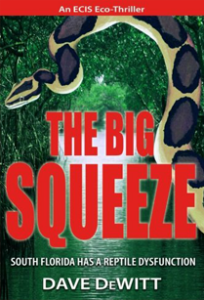 The Big Squeeze, by Dave DeWitt. Albuquerque: Sunbelt Editions, 2018.
The Big Squeeze, by Dave DeWitt. Albuquerque: Sunbelt Editions, 2018.South Florida has a reptile dysfunction. Tens of thousands of huge, feral Burmese pythons have taken over the Everglades and the suburbs of Miami and are decimating the wildlife, eating house pets, and terrorizing the populace. Sam Dalton, formerly of NCIS, is still tormented by the suspicious death of his wife and son in an car crash nearly a decade ago. He is recruited by his best friend Phil Everett to join him as a special agent with the Florida Fish and Wildlife Conservation Commission to investigate wildlife crimes, including reptile smuggling, perhaps the main cause of the python explosion. Their main suspect is Bruno Zimmerman, the owner of World of Reptiles, the largest reptile retailer in Florida. Also investigating Zimmerman is the ruthless and hedonistic investigative reporter Diana Ventura, who is undercover as the spokesperson for Save Our Snakes, an organization controlled by Zimmerman. As the investigation draws them closer together, sparks fly between Dalton and Diana. Unbeknownst to the investigators, outside of Everglades City, chemical engineer and honorary redneck Big Ink—so named for his outrageous tattoos—runs the Manatee Fish Meal Plant, a cover for a crystal methamphetamine production facility funded by moneyman Bone Mozell, the distributor of the fish meal and other products for Florida chicken farmers. Mozell’s silent partner in the meth operation is Bruno Zimmerman, and they make a good pair, since they are both sociopathic killers. They plot to take out Big Ink because of his meth addiction. When the two rogue Florida wildlife agents try to destroy all the pythons with a GMO snake virus, a wildlife disaster ensues and sparks dangerous encounters with ruthless reptile smugglers, murderous meth makers, and devious assassins in a tale of vengeance, violence, and sexual intrigue.






